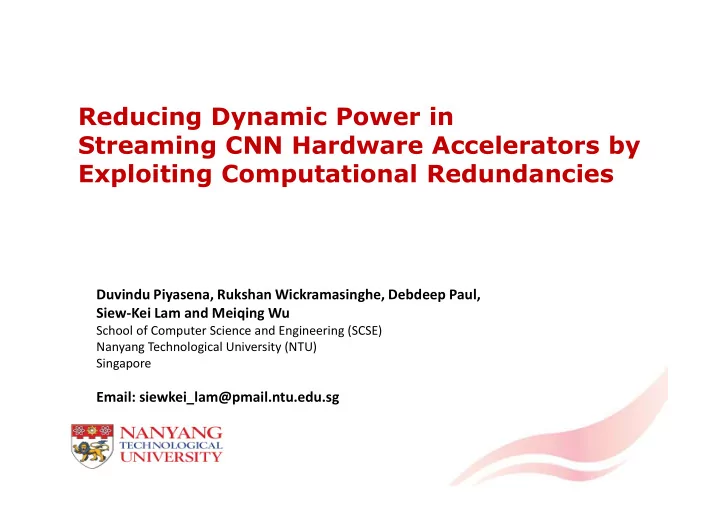

Reducing Dynamic Power in Streaming CNN Hardware Accelerators by Exploiting Computational Redundancies Duvindu Piyasena, Rukshan Wickramasinghe, Debdeep Paul, Siew-Kei Lam and Meiqing Wu School of Computer Science and Engineering (SCSE) Nanyang Technological University (NTU) Singapore Email: siewkei_lam@pmail.ntu.edu.sg
Motivation ReLU discards negative convolution activations causing high computational redundancy in CNNs . Widely-used CNN models discard 30%-90% CONV activations in a given layer. ReLU activation function
Proposed Method • We propose a method to eliminate the computational redundancies to save dynamic power in FPGA stream-based CNN accelerators • Eliminates the computational redundancies arising from ReLU activation by predicting the positive/negative CONV activations using a low-cost approximation scheme . Conventional CNN layer Proposed CNN layer
Contribution We propose a hardware-friendly convolution approximation method that rely on power-of-two quantized weights. We show that the proposed methodology can be applied to various CNN models to significantly reduce the convolution operations, without compromising on the accuracy or retraining . We propose a streaming CNN FPGA accelerator that integrates our approximation method and demonstrate that notable power/energy savings can be achieved .
Proposed Method 1. Initialize 2. Perform Logarithmic Quantization 1. Saturate weights at 99 th percentile (= W 99 ) W a = {0, ±(½) m , ±(½) m+1 ,. . . ., ±(½) m+NL-1 } Set N L = 8 2. ApproxConv weights <--- W a Set m = log2( W 99 ) 3. Original Weights 3. Validation on modified model Yes Δ 4. Reduce quantization loss level count < 1% NL = NL - 1 No 5. Final quantization mapping W a = {0, ±(½) m , ±(½) m+1 ,. . . ., ±(½) m+NL }
Implementation • Quantization level search Evaluated designs : – Prop - 1 : Approximation applied across all-layers – Prop - 2 : Approximation applied across all-layers except 1 st Prop-2 Prop-1
Implementation • Implementation done in Verilog HDL for Lenet – Operating Frequency : 100Mhz – Device : Xilinx Virtex Ultrascale+ xcvu9p – Synthesize tool : Xilinx Vivado 2018.3 – Simulator : Mentor Modelsim 10.3 – Power Estimation Mode : Post-Synthesis Timing Simulations • Power Gains achieved by clock gating CONV circuitry via ApproxConv predictions Baseline HW Proposed HW (single layer) (single layer)
Accuracy and Hardware Evaluations • Compared with Signconnect proposed in previous work(*), which uses the sign of the weights to perform the approximations – SignConnect-1 : Approximation applied across all-layers – SignConnect-2 : Approximation applied across all-layers except 1 st * T. Ujiie, M. Hiromoto, and T. Sato, “Approximated prediction strategy for reducing power consumption of convolutional neural network processor,” in 2016 IEEE Conference on Computer Vision and Pattern Recognition Workshops (CVPRW) , June 2016, pp. 870–876
Summary • Methodology to determine the minimal number of power- of-two quantization levels for realizing lightweight convolution approximations that can predict the positive and negative convolution activations. • Proposed a streaming CNN FPGA accelerator that integrates our approximation method. • FPGA synthesis results show that the dynamic power can be reduced by 10-12% while maintaining good accuracy.
Thank You
Recommend
More recommend